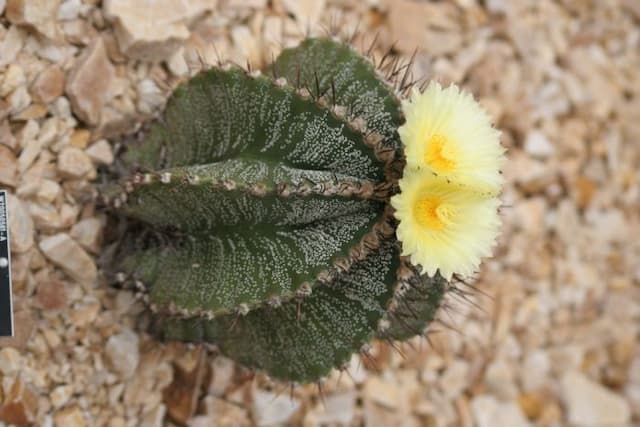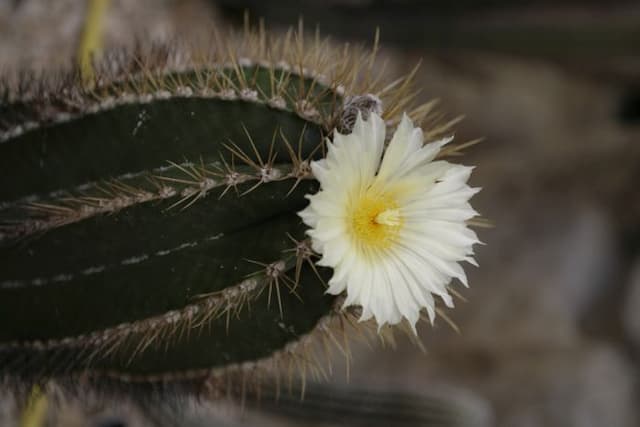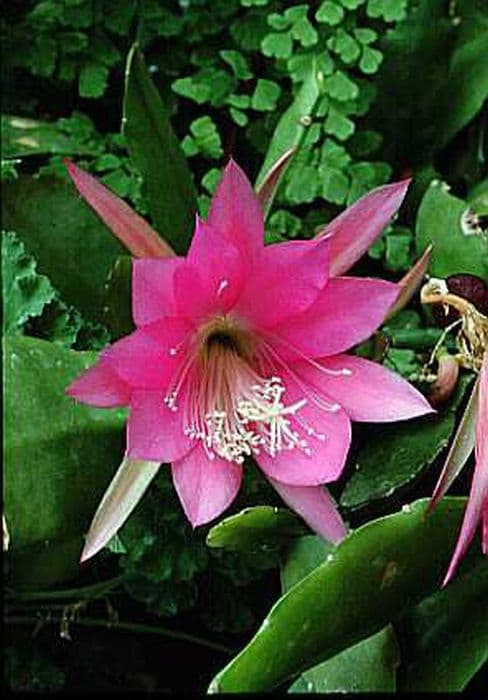Coast Barrel Cactus Ferocactus viridescens

ABOUT
The plant commonly known as the fishhook barrel cactus has a distinctive shape that is cylindrical and resembles a barrel. It is named for its curved spines, which resemble fishhooks. The surface of the cactus is ribbed, with protruding ridges running vertically along the plant's body. Between these ridges, the cactus is adorned with areoles, which are small, cushion-like structures from where the spines and flowers emerge. The spines themselves come in different shades, from yellow to red or even gray, and vary in length, providing the plant with a unique texture and appearance that can appear almost bristly. The fishhook barrel cactus is also known for its vibrant flowers, which tend to be a radiant yellow or occasionally red, sitting atop the cactus like a crown. These flowers bloom in ring clusters and can add a pop of color, contrasting sharply with the green of the cactus itself. Additionally, the fruit of the fishhook barrel cactus is shaped like a barrel and remains attached to the plant, offering a visual treat with its bright yellow or red hues when ripe. The overall appearance of the fishhook barrel cactus is striking, with its combination of formidable spines, colorful flowers, and fruits set against the backdrop of its robust and hardy green body.
About this plant
 Names
NamesSynonyms
San Diego Barrel Cactus, Coast Barrel Cactus, Green-stemmed Viznaga, Keg Cactus.
Common names
Ferocactus viridiscens, Ferocactus viridescens var. viridescens, Echinocactus viridescens.
 Toxicity
ToxicityTo humans
The common name for Ferocactus viridescens is Coast Barrel Cactus. This cactus is not typically considered toxic to humans. However, like with many cacti, the spines can cause physical injury if handled improperly. If the spines puncture the skin, they can lead to irritation, pain, and potential infection if not properly cleaned and treated. There is no documented toxicity from ingesting parts of the Coast Barrel Cactus, so poisoning symptoms from ingestion are not a concern for this particular species.
To pets
The Coast Barrel Cactus is not known to be toxic to pets. The primary concern with pets, similar to humans, would be the risk of injury from the sharp spines. If a pet were to come into contact with the spines, they could experience pain, swelling, and potential infection from the puncture wounds. Pet owners should keep their pets away from the cactus to prevent such physical injuries. There are no specific symptoms of poisoning associated with this plant since it is not considered poisonous to animals.
 Characteristics
CharacteristicsLife cycle
Perennials
Foliage type
Evergreen
Color of leaves
Green
Flower color
Yellow
Height
1-2 feet (0.3-0.6 meters)
Spread
1-2 feet (0.3-0.6 meters)
Plant type
Cactus
Hardiness zones
9
Native area
California
Benefits
 General Benefits
General Benefits- Aesthetic Appeal: Ferocactus viridescens, commonly known as Coast Barrel Cactus, adds a unique structural element to gardens and indoor spaces with its attractive ribbed, cylindrical shape and spiky appearance.
- Drought Tolerance: Being a cactus, it is highly drought-tolerant, requiring minimal water, making it an ideal plant for xeriscaping and water-wise gardens.
- Low Maintenance: The Coast Barrel Cactus is easy to care for, needing little in the way of pruning, fertilizing, or pest control, hence it’s suitable for beginner gardeners or those with limited time.
- Heat Resistance: This plant thrives in hot, sunny conditions, making it perfect for rock gardens, desert landscaping, or areas with intense summer heat.
- Long Lifespan: Cacti, including the Coast Barrel Cactus, are known for their longevity, often living for many decades with proper care.
- Wildlife Habitat: The cactus provides shelter and food for certain types of wildlife, including birds and insects, which may use it for nesting or as a food source.
- Soil Erosion Control: The root system of Ferocactus viridescens helps to stabilize the soil in which it’s planted, aiding in the prevention of soil erosion, particularly in arid regions.
- Educational Interest: Cacti like the Coast Barrel Cactus can serve as an educational tool to learn about desert ecosystems, plant adaptations, and water conservation strategies.
 Medical Properties
Medical Properties- This plant is not used for medical purposes.
 Air-purifying Qualities
Air-purifying QualitiesThis plant is not specifically known for air purifying qualities.
 Other Uses
Other Uses- The coastal barrel cactus is sometimes used as a living fence or barrier to deter people or animals from entering certain areas due to its spiky exterior.
- Enthusiasts of miniature plants and succulents cultivate coastal barrel cactus as a bonsai plant, manipulating its shape and size for decorative purposes.
- Due to its robust and striking appearance, the coastal barrel cactus is often employed in xeriscape landscaping to create aesthetically pleasing, water-wise garden designs.
- In certain regions, the coastal barrel cactus is planted as part of ecosystem restoration projects to help stabilize the soil and provide habitat for native species.
- The fruit of the coastal barrel cactus can be used in the creation of dyes for fabrics, providing a natural coloring option.
- Some artists use slices of the coastal barrel cactus, once dried, as natural canvases for painting or other forms of artwork.
- The thick, fleshy body of the plant is sometimes used in outdoor survival situations to store or collect small amounts of water, although this use is rare and not always recommended.
- The ribs of the coastal barrel cactus are sometimes used in traditional crafts, such as creating the structure for birdcages or other small, decorative items.
- In regions where it is native, the coastal barrel cactus can serve as a natural landmark or wayfinding tool due to its distinct shape and size.
- Photographers and nature enthusiasts value the coastal barrel cactus as a subject for its unique form and as an emblem of desert beauty, contributing to ecotourism and educational materials.
Interesting Facts
 Feng Shui
Feng ShuiThe Coast Barrel Cactus is not used in Feng Shui practice.
 Zodiac Sign Compitability
Zodiac Sign CompitabilityThe Coast Barrel Cactus is not used in astrology practice.
 Plant Symbolism
Plant Symbolism- Resilience and Strength: The Ferocactus viridescens, commonly known as the Coast Barrel Cactus, is known for its ability to thrive in arid conditions, standing as a symbol of resilience and strength in the face of adversity.
- Independence: This cactus is adapted to live with minimal dependency on external water sources, symbolizing independence and self-sufficiency.
- Protection: With its formidable spines, the Coast Barrel Cactus represents protection and defense against unwelcome intrusions.
- Adaptability: Its capacity to adapt to harsh environments signifies flexibility and the ability to adjust to changing circumstances.
- Longevity: Barrel cacti generally have a long lifespan, which makes them a symbol of endurance and long-term survival.
 Water
WaterThe Coast Barrel Cactus should be watered deeply but infrequently. Allow the soil to dry out completely between waterings, which typically means watering every two to three weeks during the active growing season in spring and summer. In the fall and winter, reduce watering to once a month or less, depending on the humidity and temperature in your area. When you do water, provide enough water so that it runs out of the bottom of the pot, usually about a quart for a medium-sized pot. Over-watering can lead to root rot, so err on the side of underwatering rather than giving too much.
 Light
LightThe Coast Barrel Cactus thrives best in full sun conditions, so place it in a spot where it will receive direct sunlight for at least six to eight hours a day. In an indoor setting, a south-facing window is typically the ideal location for maximum light exposure.
 Temperature
TemperatureThe Coast Barrel Cactus can tolerate a wide range of temperatures but prefers warmer conditions. It can survive temperatures as low as 25°F but thrives in temperatures between 70°F and 100°F. Protect it from frost and extended cold weather to prevent damage to the plant.
 Pruning
PruningPruning is generally not required for the Coast Barrel Cactus, as its natural shape is typically maintained without intervention. If necessary, remove any dead or damaged spines or portions of the cactus to maintain its appearance, doing so carefully with proper gloves and tools. The best time for any pruning would be in the spring before the growing season begins.
 Cleaning
CleaningAs needed
 Soil
SoilCoast Barrel Cactus prefers a well-draining soil mix consisting of 50% pumice or perlite mixed with 50% cactus potting soil to ensure proper drainage. The ideal soil pH for this cactus should be mildly acidic to neutral, ranging from 6.0 to 7.5.
 Repotting
RepottingCoast Barrel Cactus should be repotted every 2 to 3 years or when it outgrows its current container to provide fresh soil and prevent root crowding.
 Humidity & Misting
Humidity & MistingCoast Barrel Cactus thrives in low humidity environments typical of arid regions, and does not require high humidity levels, making it well-adapted to indoor air conditions.
 Suitable locations
Suitable locationsIndoor
Place Coast Barrel Cactus in a sunny spot.
Outdoor
Full sun, well-draining soil, protect from frost.
Hardiness zone
9-11 USDA
 Life cycle
Life cycleThe life of the Coast Barrel Cactus (Ferocactus viridescens) starts with the germination of seeds, which is heavily dependent on the right temperature and water conditions. After germination, it enters a juvenile phase, characterized by slow growth and development of its characteristic ribbed, barrel-shaped body and spines. As it matures into adulthood, which can take several years, the plant increases in size and may begin to produce bright yellow flowers at the crown during spring or summer. These flowers are pollinated by insects and possibly birds, leading to the development of fleshy fruits containing seeds, which on maturing, are dispersed by wildlife. In its adult stage, the Coast Barrel Cactus can withstand extreme desert conditions, going through cycles of dormancy and growth as seasons and water availability dictate. This cactus has a long lifespan, often living for several decades, with some specimens surviving to over a hundred years.
 Propogation
PropogationPropogation time
Spring-Early Summer
The most popular method of propagation for the coast barrel cactus (Ferocactus viridescens) is through seeds. The best time to sow coast barrel cactus seeds is in the spring or summer when temperatures are consistently warm, which is conducive to germination. To propagate by seeds, one should prepare a well-draining soil mix and place the seeds on the surface, then lightly cover them with a thin layer of sand or soil. The soil should be kept moist but not waterlogged, and the pot should be placed in a warm area with plenty of indirect sunlight. Seedlings will emerge in a few weeks to a few months, depending on the conditions. After the seedlings have grown enough to handle, they can be carefully transplanted into their own pots to continue growing into mature cacti.









